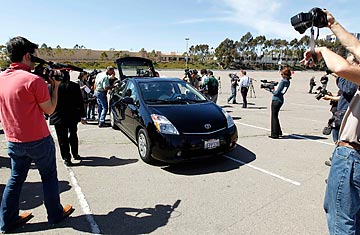
A 2008 Toyota Prius in a parking lot, after the automaker announced preliminary findings in its investigation of an unintended-acceleration incident
On Monday, Toyota released preliminary findings related to its investigation into the case of James Sikes, the driver of a 2008 Prius who said his car ran away from him on a San Diego area freeway, an incident recorded in a 22-min. 911 call as well as by dramatic pictures.
Mike Michels, Toyota's vice president of communications, said the vehicle was examined by Toyota's engineers, who downloaded data from the vehicle, inspected it carefully and drove it through a series of tests. "There are strong indications that the driver's account of the event is inconsistent with the findings of the preliminary analysis," Michels said.
The Prius incident is one of two episodes of sudden acceleration that Toyota is scrambling to respond to. The company has engaged a respected engineering consultancy, Exponent, which has a staff of more than 900 engineers, to see if it can discover the root cause for the runaway cars.
Exponent has also played a part in challenging a sudden-acceleration experiment on a Toyota Avalon conducted by researchers at Southern Illinois University. The SIU study was presented to Congress and highlighted by ABC News, but the report was called into question when the university's researchers were found to have deliberately changed the accelerator-pedal wiring to induce the sudden acceleration.
In Monday's press briefing, the automaker raised several questions about Sikes' account. Michels said the car's accelerator pedal was found to work normally, as was the pushbutton power switch, which "shut the vehicle off when depressed for three seconds, as the 911 operator advised Mr. Sikes to do." Michels also said the car's gear-shift lever worked properly under testing.
And what about the car's software? According to preliminary findings, there were no diagnostic trouble codes found in the power-management computer, Michels noted, nor was the dashboard's malfunction-indicator light activated; also, the floor mat was in the correct position. Toyota has identified floor mats as one cause of past sudden-acceleration problems.
The one anomaly that Toyota's engineers couldn't explain was the heavy wear on the front brakes, which Toyota officials admitted was consistent with Sikes' assertion that he tried to brake the car.
"Today's conference occurred to raise questions on Mr. Sikes' actions last Monday but does not go far enough as to clear the air on the what-ifs that sit like an elephant in the middle of [Toyota's] story," noted James Bell, a senior analyst with Kelly Blue Book. "We appreciate that such an issue is difficult to replicate and test, but we don't believe this press conference has put the public's mind at ease just yet."
